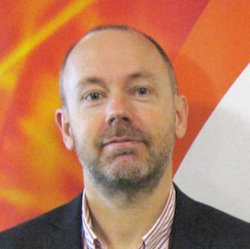IMI Europe Inkjet Development Conference
17-18 April 2018
Mövenpick Hotel Frankfurt City, Frankfurt, Germany
Conference Programme
The IMI Europe Inkjet Development Conference is aimed at inkjet development chemists and engineers looking to find out the latest products, technology and techniques, and exchange ideas with peers. The conference covers materials, characterisation, formulation, printing, curing and other aspects of digital printing solutions.
TECHNICAL ADVISORY BOARD
The conference is guided by a Technical Advisory Board consisting of key industry and academic figures, including:
Prof Reinhard Baumann, Technische Universität Chemnitz
Dr Phil Bentley, Head of Fluids, Tonejet
Dr Andy Hancock, Technical Director, Mexar
The Technical Advisory Board is chaired by Dr Tim Phillips of IMI Europe.
presenting companies
Armor Industrial Inks | DoDxAct | Epivalence/University of Liverpool | Fraunhofer Institute for Electronic Nano Systems (ENAS) | Global Inkjet Systems | ImageXpert | Inca Digital | INM - Leibniz Institute for New Materials | Meteor Inkjet | Microtrac | Reden | Rahn/RadLab | Sensient Imaging Technologies | Sun Chemical | System | Technische Universität Chemnitz | Tiger Coatings | Tonejet | Zschimmer & Schwarz
Additional Benefits
Networking
Meet with suppliers, industry experts and developers from other companies at our complimentary networking breaks, lunches and evening drinks reception. Excellent refreshments will help you enjoy this key part of the conference.
Sponsor Exhibits & Forum
Event sponsors will have their products and technology on display in the breakout area. In addition the Sponsors' Forum enables you to hear short presentations from sponsors with their latest news. If you are interested in becoming an event sponsor, please visit our sponsorship page.
Conference Programme
Tuesday 17 april 2018
Energy curing inks - future directions
Hugh Allen, Development Manager Inkjet Inks, Sun Chemical
UV-curing inkjet inks are well established in graphics, label and industrial decoration and beginning to be utilised in packaging applications. However, with the advent of increasingly capable LED curing devices there are now three options available for curing the inks: mercury, LED or ebeam. This presentation will consider the implications these curing methods have on ink design and their relative pros and cons. Additionally, the impact that printhead choice has on curing as well as regulatory, food safety in the area of packaging and image quality considerations will be discussed.
Textile inks for direct printing - the challenges of drop control and material selection
Dr Simon Daplyn, Marketing Manager, Sensient Imaging Technologies
Textiles offer a significant challenge to printers in terms of achieving the colour, sharpness and application performances expected from major brands on a porous and absorbent 3D structure. This challenge can be increased with ever tighter controls on materials that can be used and evolution of new printheads and equipment driven to increase production speeds. This talk will focus on the technical challenges of drop control, requirement for pre-treatment and how materials selection impacts on sustainability and brand compliance.
Importance of hybrid print processes in the digital evolution
Dr Mark Bale, Director, DoDxAct
As digital print continues to penetrate industrial applications beyond wide format, the role of hybrid processes has become prominent. Despite early scepticism, offline pre-coating or inline priming of difficult surfaces has become accepted to deliver the required image quality and functionality, particularly in single-pass printing. We review examples from across proven applications and look to the future of the still-evolving landscape in textile and packaging markets.
Requirements and challenges in aqueous inks for flooring and packaging
Frank de Jonge, Business Development Director, Armor Industrial Inks
The presentation will examine the opportunities for water-based inkjet inks for key applications like flooring and packaging. In these cases the requirement for application performance and jettability presents significant formulation challenges based on the need for significant pigment loading and binder concentration. These challenges, along with substrate compatibility, pre- and post-treatment methods and suitable curing technologies will be discussed for each application, and latest developments presented.
Panel discussion: Inks for packaging - what is missing?
UV versus aqueous inks
UV, LED, EB curing
Migration and regulatory issues
The panel will be chaired by Dr Andy Hancock, Technical Director, Mexar, and include industry experts from the conference Technical Advisory Board and conference presenters.
An overview on the development of inkjet printed thin-film-transistors based on materials, architectures, deposition technology as function of performance, reliability and their implementation in flexible electronics
Dr Kalyan Yoti Mitra, Department of Digital Printing and Imaging Technology, Technische Universität Chemnitz, with Sunil Kapadia, Maxim Polomoshnov, Reinhard R. Baumann and Ralf Zichner (Fraunhofer Institute for Electronic Nano Systems, Department of Printing Functionalities)
Development of nanoparticle inks with active matrix materials
Dr Casey Dixon, Research Chemist, EpiValence, with Simon Rushworth (Epivalence), Josh Turner, Helen Aspinall and Kate Black (University of Liverpool)
The challenge of reducing the thermal treatment conditions required for metal oxide thin films to enable deposition on flexible, plastic substrates has proven to be a significant barrier to creating novel devices using inkjet printing. In this talk the use of preformed crystalline nanoparticles in active matrix will be discussed and results from the development of two active matrices presented. Properties of a variety of formulations including modified metal alkoxides in functional alcohol with and without glyme stabilisers will be reviewed to highlight the optimum compositions of inks for future testing. Some printed pattern results using the highest potential inks will also be included to demonstrate the advantages of the approach that have been achieved to date.
Innovation of series production by digital printing processes like inkjet and dispensing for printed electronic applications
Dr Ralf Zichner, Head of Department Printed Functionalities, Fraunhofer Institute for Electronic Nano Systems ENAS, with Robert Thalheim, Reinhard Baumann, Thomas Otto
Across industries, the demand for innovative, individualised components is growing. Producing these efficiently down to a quantity of one requires the use of digital production processes like inkjet and dispensing processes. One strategy for realising component customisation is to digitally apply functional material (e.g. electrically conductive pattern) on top. With this for example printed paths on planar and 3D objects could be realised. The advantages and applicability of digital printing technologies (inkjet and dispensing) will be described by an automotive application: printed wiring harnesses.
Improvement of the thermal stability of inkjet printed silver grids by wet chemically deposited TCO coatings
Dr Thiago Martins Amaral, INM - Leibniz Institute for New Materials, with Sabine Heusing, Peter König, Peter W. de Oliveira
Panel discussion: Functional printing and printed electronics
Technology barriers
Latest developments
What more can the industry do?
The panel will be chaired by Prof Reinhard Baumann, Technische Universität Chemnitz, and include industry experts from the conference Technical Advisory Board and conference presenters.
Imaging of inkjet drops in flight
Yair Kipman, President, ImageXpert
With the help of cutting-edge machine vision technology, inkjet research and development is becoming faster, more comprehensive, and more automated. In this presentation, the latest tools and techniques for studying drop formation, waveform optimization, operating frequency, and other aspects of ink characterization will be discussed.
Hear short presentations from the event sponsors.
Join us for wine, beer, canapés and good company!
wednesday 18 april 2018
Ink mist in single pass printing
Dr Will Eve, Director of Technology, Inca Digital Printers
Ink mist is a particular concern with single pass printing. Ink mist can contaminate nozzle plates and cause jetting reliability issues, and single pass printing requires very high reliability. The very large amounts of ink printed by a single pass system means there is the potential for large amounts of mist, so that systems are needed for extracting and separating the mist. The factors affecting mist generation will be described, as well as looking at mist entrainment in airflows in the print gap.
Electrostatic printing of industrial packaging: New developments in direct-to-shape metal beverage can printing
Dr Phil Bentley, Head of Fluids, Tonejet
A revolution is afoot in the requirement for printed metal beverage cans. Small craft brewers require short print runs of around ten thousand cans, much smaller than the minimum order from a traditional can printer. A digital direct-to-shape solution is thus required to unlock the growing demands of short-run can printing. The beverage can is an extremely demanding surface, being non-porous and of low surface energy. The ink layer must be low cost, vanishingly thin yet withstand the rigours of the shipping process. Furthermore, beverage cans have an awkward shape requiring novel engineering solutions to achieve high throughput in a digital printer without substrate damage. This talk will discuss these challenges in detail and present some of the novel approaches Tonejet has taken in building a solution.
Improvement of printing quality through satellite formation control
Dr Ilaria Valenti, Physical Engineer, System
This work describes a method to improve printing quality, through the control of satellite formation mechanism, which is a direct consequence of drop formation process. The method is based on a model presented and experimentally verified in a previous study, relating drop velocity to satellite number, through tail length at the detachment from nozzle. A brief presentation of the model for single event condition is introduced, then the model is here generalised including frequency effects. A parameter to evaluate printing quality a priori, from ink and printhead properties, is introduced and the dependence from single relevant quantities is highlighted. An actual example of tuning of ink properties is presented and the effect on drop formation are experimentally analysed. A very general method to improve printing quality is proposed, which is applicable to each printing system, opening the way to the possibility to create modellable fluids with the best printing performances.
Efficient modelling of substrate behaviour and design rule extraction
Jakko Nieuwenkamp, Senior Engineer, Reden
Print quality is affected by many factors: the positioning and the temperature of the substrate being two key considerations. A model has been made that is able to calculate the temperature in a sheet of paper while travelling through the paper path system. The efficiency of the calculation method is such that the temperatures can be calculated real time and integrated in the control loop. Print quality is badly influenced when the substrate wrinkles. Models have been made to predict the wrinkling of the substrate. Based on these models design rules are made for efficient use in the design process of new print applications.
Software – key application and print quality enabler
Dr Sarah Driver, Application Specialist, Global Inkjet Systems
A huge number of factors contribute to achieving and maintaining image quality, such as inks, process, mechanical, encoders, substrate, curing etc. Most of these are now well understood, enabling larger and wider inkjet presses to be built, but also increasing is the probability of a shorter mean time between failures. This presentation will concentrate on one of those key factors – software – firstly focusing on certain aspects which are becoming increasingly critical as the number of printheads per system grows. Missing nozzle strategies, printhead linearisation and advanced stitching techniques will be discussed. This presentation will also discuss how software is the critical enabling tool to unlocking new applications for inkjet, in particular, for printing onto complex shapes.
Electronics – essential components for high performance inkjet printing
Clive Ayling, Managing Director, Meteor Inkjet
The talk will explain the differences between electronics needed for different printhead types and why they differ for the same head in different applications. Recent trends in industrial reliability and in print quality have driven changes in drivers in their analogue hardware, digital hardware and embedded software functionality. These changes will be discussed and the impact of improved electronics and software technology on the production of the latest high-performance inkjet machines.
A new combination instrument to monitor pigment size and shape
Dr Thomas Benen, Sales Manager D-A-CH, Microtrac
As printhead and inkjet technology are progressing, the demand for characterisation of inks regarding their pigment size, single oversized grains and colloidal stability is increasing. The size of pigments has an impact on factors like printability, printhead blockages, sharpness of texture, optical density and color gamut. Microtrac introduces a new technology which combines, for the first time, data from laser diffraction and dynamic image analysis. The size distribution of the inkjet ink is measured by the laser technology, while the optical image detects size and shape of larger particles. This enables users to monitor the milling process, to assess the final product and to detect single oversized particles or clumps which cause a risk for blockages.
The digital revolution in textile printing – requirements and trends for inkjet inks and textile chemistry
Dr Enrico Sowade, with Andreas Schönfeld, Textile Auxiliaries Division, Zschimmer & Schwarz
Screen printing was the initial choice for the textile printing industry. During the last years, digital textile printing based on inkjet printing technology is attracting increasing interest and the market is growing rapidly. In some textile market segments, there is already a clear transition from the traditional screen printing technology to digital printing technologies. Due to the rising customisation trend, smaller production batch sizes, requests for faster product availability and higher ecological requirements, digital textile printing is becoming more and more mainstream. Different digital textile inks focusing on pigment-based ink formulations and their interaction with the textile fibres will be introduced as well as special pre- and post-treatment chemistry dedicated to digital textile printing with high performance. This talk will also introduce functional features for textiles and casts a glance on the potential digital application of these functions.
Stabilisers for UV curing inkjet formulation
Dr Roberto Bianchi, Head of Research & Development RadLab, Rahn Group
UV curable inkjet inks are designed to be very reactive so the printed droplets can be cured quickly and efficiently when exposed to UV, LED or e-beam radiation. Ethylenically unsaturated bonds react to any free radical (generated for instance by photoinitiators) when exposed to UV or LED lamps, polymerising to provide a cured film. The ink needs to be protected against unwanted polymerisation or gelation, which can happen in the ink container, in the dark, and will render the ink unsuitable for printing. In addition, unwanted polymerisation inside the printhead can occur, causing clogging and damaging the printhead. In this paper some explanation for this is provided. Strategies to protect the ink both during its shelf life and inside the nozzle are presented.
Water-based inkjet inks for industrial applications
Dr Iurii Gnatiuk, Product Manager Technical, Tiger Coatings
The distinct wish of industry to work with water-based ink solutions in customised digital decoration of surface for sensitive applications like non-direct food contact, pharma, skin contact, interior, etc. is becoming more and more obvious. The practical realisation of these processes with water-based ink solutions is connected with a number of challenges, among them: interaction of water-based inks with absorbing and non-absorbing substrates, control of drop spread and colour-to-colour interactions, water-based ink properties and availability for jetting at the required time (decap time) at high printing speed. In the talk our approaches for the realisation of single pass printing with water-based inkjet inks with different final ink fixation on the substrate (thermal or UV-curing) will be presented and discussed.



























